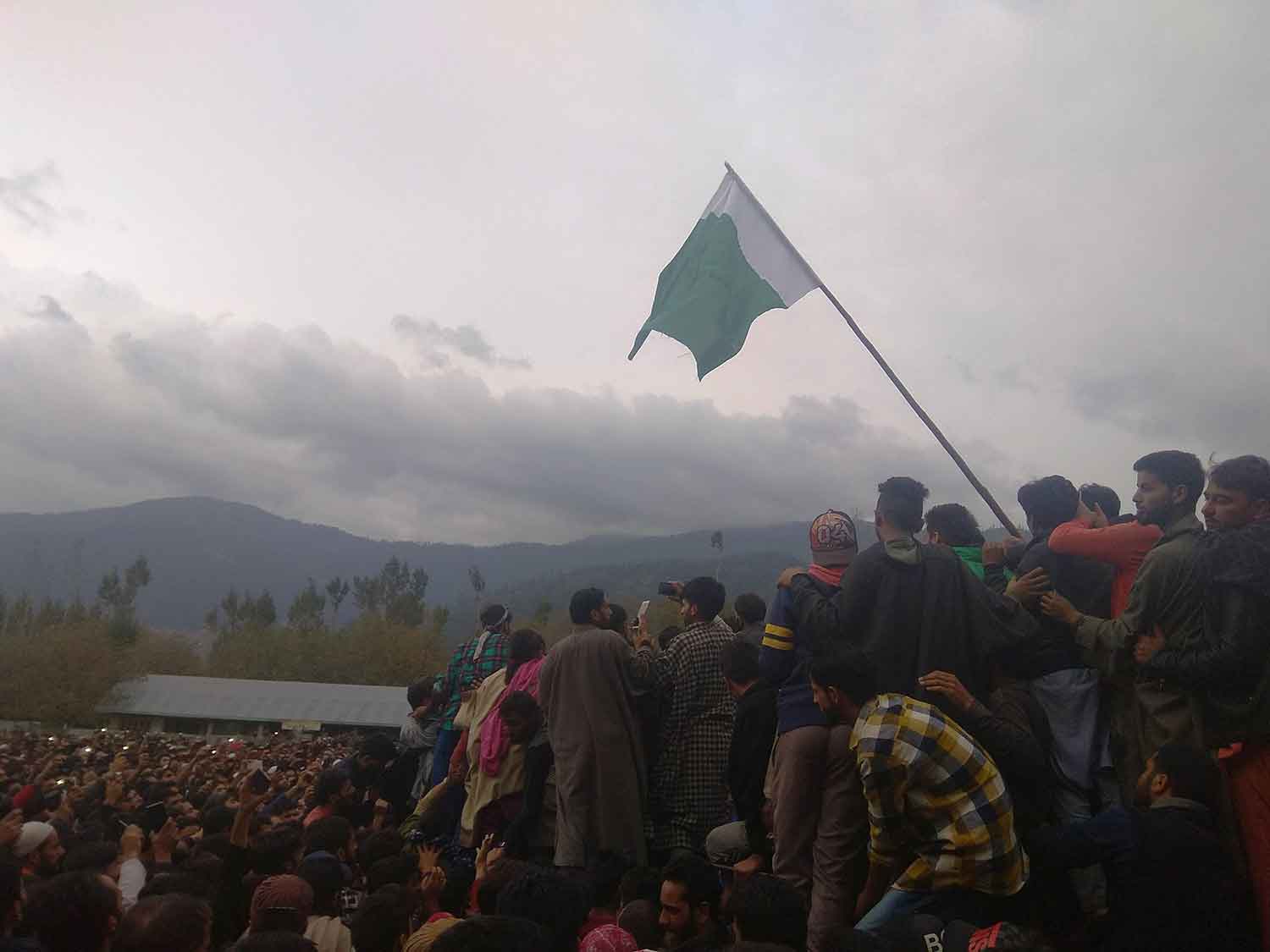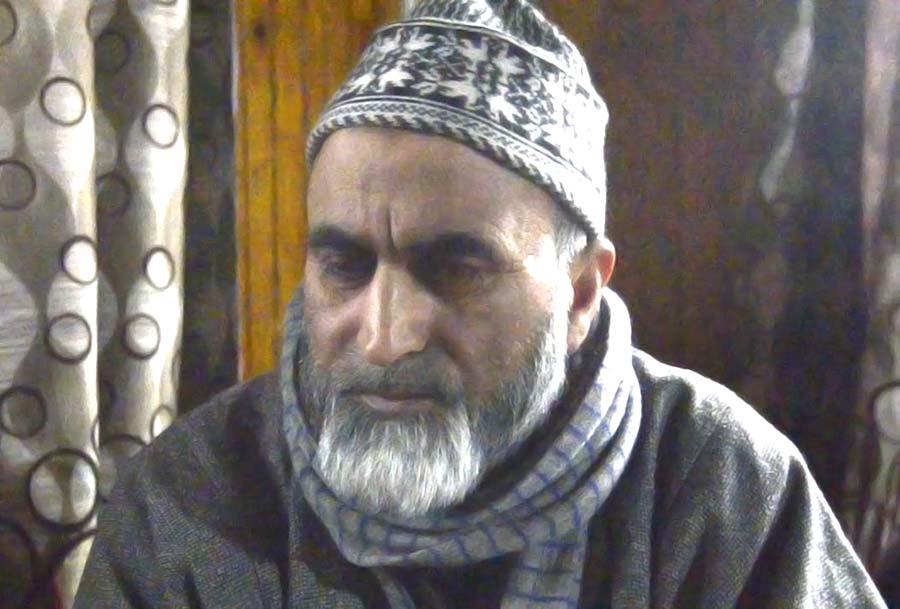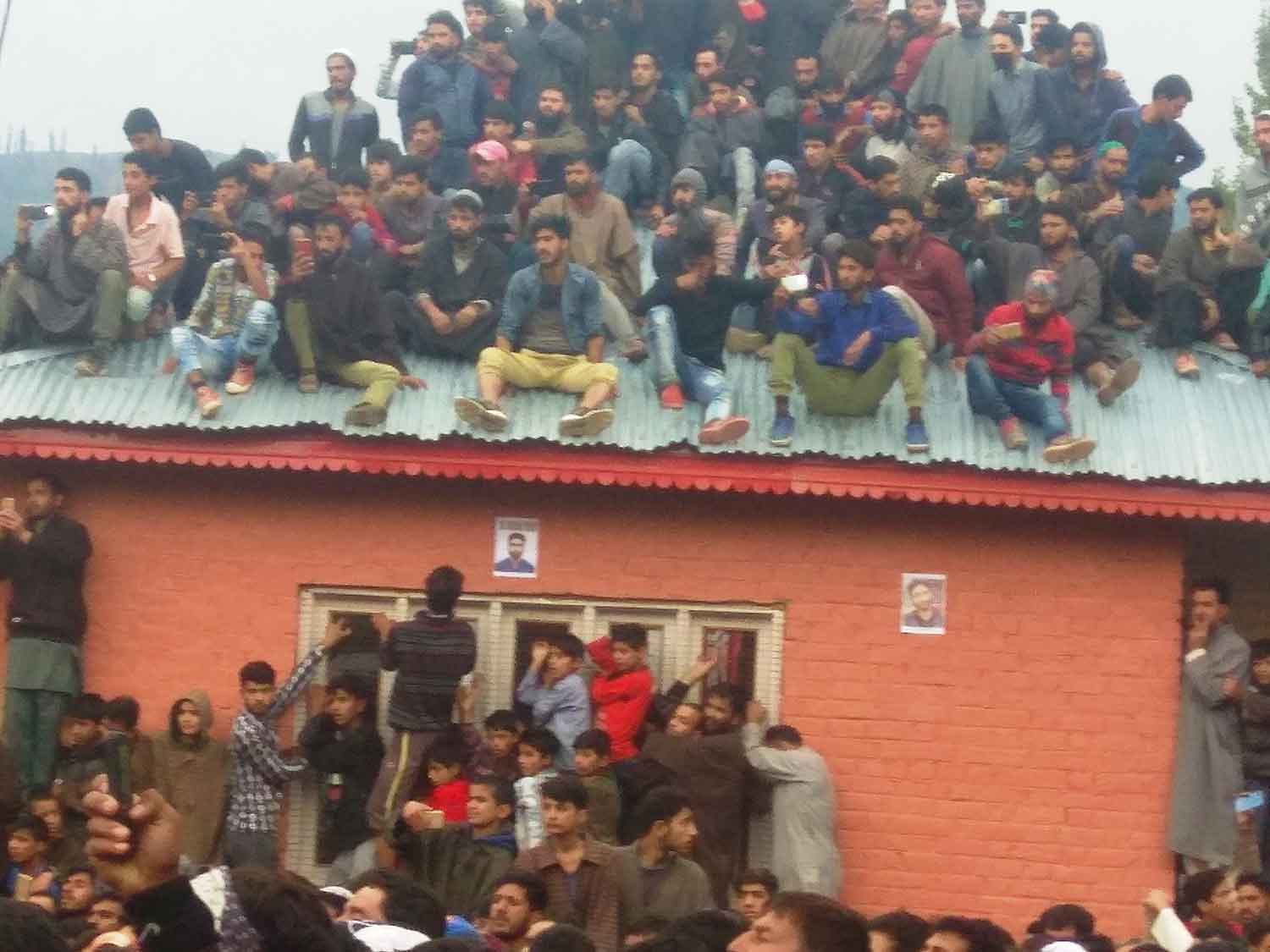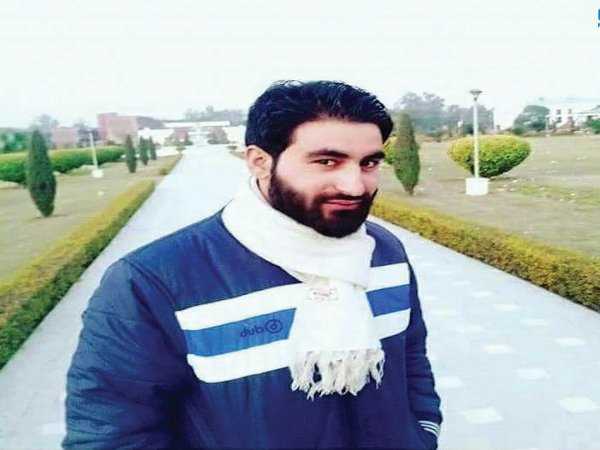‘Prepared’ to derail another high-voltage ‘Wani Wave’ from spreading across the Kashmir Valley, the state had put some tough measures on Thursday — even debarring journalists from covering the funeral of the scholar rebel. But some scribes did manage to reach Tikipora to cover Manan Wani’s final return as the native. Here an independent journalist from Kashmir details his day out on the ‘overwhelming’ reporting trip.
As the pre-dawn gun-rattle sealed the fate of the scholar rebel in a sleepy Langate hamlet on October 11, I left with my journalist colleagues to cover the funeral. The word had it that Dr. Manan Wani’s hometown movement had lately come on the sleuths’ radar. Days later as he was tracked, his passage was to become the massive moment — given the scholar’s sway over the masses, aided by his two articles detailing the method behind his pen-to-gun shift.
Unlike in another Wani’s (Burhan’s) case, the state was literally on its toes. Apparently, they had understood that the fallen militant was no regular rebel. Perhaps that’s why they took time to declare his demise. And when they did, the gun-cocked state forces were all over the streets, checking and managing dissent.
Our car started slow, often halting on the road to inquire about the situation in the Kupwara town. The traffic on Srinagar- Baramula highway was thin, and was thinning more and more as we drove closer towards Kupwara.
On the highway, the CRPF and police vehicles were standing put. Both police and paramilitary forces were tense; their guns in hand, ready to crush any protest from the people.
At Pattan and Palhallan, the shops were shut, like there were at many townships and villages we drove through. People were sitting on shop-fronts, sullen faced.
As we drove out of Sopore, the traffic on the highway had abbreviated, more suddenly. An occasional vehicle, mostly an apple laden truck, would speed past us. On both sides of the road, near villages, stood people, in groups of ten to twenty, perhaps discussing the killing of Mannan.
The youth were darting the roads with stones in their hands. Wooden logs and small stones were used to barricade the highway, unsuccessfully. Soon a police van would chase the youth away.
The highway ahead of us was desolate.
“The landscape, the air, the road, everything is in mourning,” my colleague observed.

We reached Kupwara town in the afternoon. The police and the CRPF men had put a barricade at the bus stand, stopping every vehicle, especially the ones headed towards Lolab valley. We were stopped. They asked us where we are headed. We lied to them that we were going to Bungas valley. They didn’t, perhaps know that Bungus valley doesn’t lie to where we were heading. They let us go, after frisking the car for 10 minutes.
And then we drove towards the village of Manan Wani—Tikipora. The road was uphill, through small villages. And on our way the people, mostly youth, had come out, put barricades on the road and were ready for a battle with the state forces. The forces had, we heard, closed most main roads leading to Manan’s village. We had to divert our journey. We didn’t know the roads. A local boy in his early twenties volunteered to come with us.
Our car strolled on the muddy roads, through the gullies of villages. The people were on the roads, or on foot, marching like a flood, towards Manan’s village.
Many had long sticks with them; many were in slippers; many carried apple sacks and were distributing them to the people going towards Tikipora.
Women and men braved long distances, through the muddy paddy fields, gorges to reach the village. Old women who could barely walk were limping slowly, often accompanied with a boy or two to lead them by holding their hands.
“It’s around twenty kilometres from here. These people will travel on foot up to there,” the boy said.
We were approaching fast and sometimes slow. At one village, the villagers stopped us. “A CRPF party ahead is debarring people from moving to Manan’s village,” we were told.
We took a different route with the help of the villagers. We drove through paddy fields. The road was muddy and in fifteen minutes we reached Tikipoar—the village of Manan.

Tikipora is a village spread on a plain, wedged between small pine hills; and amidst the pine hill lies a military camp of the Indian Army—28 Bt RR, overlooking the village.
Inside, the village is a maze with small gullies, old brick houses, a paddy field here and there, a small rivulet snaking through the village. The children playing army-military in the village street carrying long sticks as guns, the women looking out of window in grief, some weeping, some angry. The overwhelming scenes had gripped the scholar’s village.
As we neared Manan’s house, the commotion rose. So did our pace and many others who were walking besides us.
The first thing I heard was the singing—the women of the village had come out in droves and were singing wedding songs. Manan was the symbolic groom. The women were huddled in groups; their songs were echoing back, rattling the ears of the listener. I looked around; tears were flowing down the cheeks, of both men and women. Here and there lay men, young boys, with red eyes, crying.
The road leading to Manan’s house was packed with people; hundreds of people—the villagers, marching on, and on. A group of young boys, as young as nine or ten, were distributing water in plastic glasses to the marchers. Many were drinking and washing their faces. Some boys climbed the trees and were shouting slogans, “Manan tere khoon say… Inqilaab aaye ga” (Your blood will bring the revolution.)
Amid those overwhelming scenes, I saw an old woman crying and distributing apples to the people. A few old men were sitting aside, smoking hookah and occasionally looking upwards, perhaps in prayer.
A boy, with a Pakistani flag in his hand, climbed a tree and waved it, triumphantly, shouting, “Pakistan…” The crowd replied—“Zindabad”—with raised fists.
In the cricket ground, where Manan used to play, outside his home, people had gathered, and many flags were being waved.

FPK Photo/Nayeem Rather
In the cacophony of slogans, it was difficult to understand the words clearly. The singing of women was going on, with more and more women joining.
“Saane Maharazoo, lagyoo ath jawaani, ath shahaadatas” (O our bridegroom, we’re indebted to your youth and martyrdom.)
We forced our way out of the crowd and headed to Manan’s house. Outside the door, hundreds of people, both men and women had gathered. They were waiting with flower garlands of different colours, baskets of toffees, like they wait for the groom, for the body of Mannan.
The body was on its way to be handed over to his family. The fence made of iron sheet was festooned with paper posters carrying Mannan’s picture. Hamza was written all over these posters. Someone put a flag of Pakistan on the fence and a small breeze fluttered the flag. People cheered.
A way was made for us. We entered. The singing continued outside. The slogans too.
Manan’s father was sitting inside, flanked by his neighbours. He was unusually solemn and calm. He was consoling others and asking them not to weep. He was discussing arrangement of funeral with others amid the sobs coming from outside and inside the room.

Bashir Ahmed Wani.
An old man entered the room. He went straight to Mannan’s father.
“Congratulations!” the old man said.
“Thanks and congratulations to you also,” Manan’s father replied, while shaking his hand. Tears welled in his eyes and vanished in the next moment. He tried to weep.
The old man who congratulated him on his son’s ‘martyrdom’, I came to know later, had also lost his son. It was solidarity of two fathers whose sons had been killed. He hid his face and looked aside. His eyes gazed blankly at the mirror. And he became silent.
The discussion on the timing of the funeral continued after a while. “Who’ll lead the funeral prayers?” a relative asked.
Mannan’s father looked at him without speaking a word. No one spoke or coughed. Tears again welled up in his eyes and he restrained them.
“I want to lead the funeral prayer myself. And I want the funeral to be held as quickly as possible,” Mannan’s father said, feebly.
The villagers wanted to wait for the funeral. They wanted the funeral prayers to be held in the Eidgah of the village. The family refused.
The family was apprehensive that the forces might come, as the Eidgah was close to the army camp. They didn’t want bloodbath.
“The army is ruthless and I don’t want any more Mannans to be killed. It is better to hold the funeral here and quickly,” said Mannan’s father.
Mannan’s friends poured into the room. They started to cry and sob. “Hoo yaraaa, meani yaaara, zuv ha wanday (O friend, my salutations to your sacrifice),” one of the friends sobbed.
The people in the room consoled them. Mannan’s father, I could sense, tried to weep, but didn’t. It was devastating to watch the father’s incapacity to cry, despite his grief being immense.
After crying, silence fell in the room. The sloganeering outside was going on, more intense as the moments passed. The singing of the women intensified.
Then the news spread: The body of Mannan has reached the village.

We all went out. The people were charged. The people climbed trees, silos, house tops; some people jumped over fences to get the last glimpse of the hero.
The body was being carried on two tractors, moving close and in tandem with each other. The discipline of the movement of the tractors was unbelievable. And on both sides, the people were walking, solemn; tears were flowing down from many faces. Out of nowhere, the pictures of Mannan on big posters emerged. Hamza, Manan’s nom de guerre was written all over. The scholar was sporting long hair and side pose on the poster.
The march of the people moved slowly, until the body was taken down from the tractors and hundreds of men, wanting to shoulder the coffin battled. Not everyone was successful. The body was taken to the cricket ground; a podium had been made. Everyone wanted to see the face of Mannan for the last time and say farewell to him.
The body was hoisted for everyone to see. Thousands of people assembled.
“It’s a sacred relic. I’ll be blessed if I see the face,” a young man told me.
Like waves in the sea, the people went forwards and backwards to get a glimpse. At least a hundred people climbed a nearby school building to see the scholar’s face. The sloganeering intensified.

FPK Photo/Nayeem Rather
I felt choked in the crowd. I was in the middle and could only see half of the body shrouded in white cloth. I could see black boots, unusually fresh without a speck of dirt, as if the shoes had been bought just now. It set off rumours. And even before I could reply to a mourner who thought the scholar was tricked before being gunned down, another wave of people dashed me forward and then backwards.
I managed, somehow, to get out of the sea of people.
At a distance I sat down on the ground. I was overwhelmed and wept. For the day, the reporter in me couldn’t maintain a professional indifference towards another funeral in Kashmir. I soon cleared my tears and went back to work.
Rumours were still flying thick and fast, when we decided to leave. As we started our car, it got stuck in mud. Many people without us asking them to help came and helped us to get the car out of the mud.
“If we were only so organised as a people we could end this occupation in a jiffy,” a young man said after our car was out of mud.
We drove out of the village.
And going down the road, people were still marching. It was dark now and we were stopped by the Army, who told us, “You cannot leave!” It was near a military camp. I showed my press credentials and after looking at it for five minutes, the army finally let us go.
We had not travelled five kilometres when we were halted at another barricade, installed by the army. I looked around and saw at least twenty vehicles, mostly cars, stranded. The passengers were standing nearby and the army didn’t allow anyone to enter the village of Mannan.
A group of journalists were there, too. They, despite showing their press credentials, were not allowed. They waved at us and we at them. They will wait, they said. We left. We drove fast and on our way found hundreds of vehicles stranded. The armed forces had shut all the roads. No one was allowed to go in.
A young man, who had travelled all the way from Islamabad to attend the funeral, said, “They don’t even allow us to mourn. They’ve snatched the right to mourning, too!”
We said nothing and left.
Nayeem Rather is an independent journalist based in Budgam.










Beware ! next wedneday india is going to show the proof of nuclear proliferation to the international community that it is providing nuclear technology to Iran from time to time